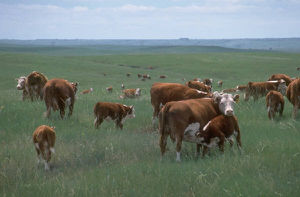Foot-and-Mouth Disease

Baltimore Classification
Group IV. Positive single-stranded RNA (picornavirus)
Higher order categories
Order Picrnovirales
Family Picornaviridae
Genus Aphthovirus
Species Bovine rhinitis virus
Description and Significance
This aphthovirus can survive a range of conditions outside of a host cell. It can persist in below-freezing temperatures as well as through the high temperatures of pasteurization, making the eradication of this virus in a cattle population and throughout its byproducts very difficult.
Herds are quickly affected with FMD due to their close contact with each other and materials that carry the virus. Cloven-hoofed livestock such as cows, pigs, sheep, goats, and sometimes llama and aplaca herds are the most often affected animals. Outbreaks of FMD have not occurred in the United States since the late 1920's but Asia, Africa, and regions in the Middle East still suffer.
It's highly contagious nature as well as it's relation to the human-affecting enterovirus that causes hand, foot, and mouth disease make it a model virus to study. If infected animals come into contact with wild herds, deer and buffalo will also become diseased and sources of food and ecological balance will be rendered dangerous.
Genome Structure
The FMDV genome consists of about 82,000 nucleotides [2]. There are seven different strains of the virus: A, O, C, Asia 1, SAT 1, SAT 2, and SAT 3.
Virion Structure of FMD virus
Reproductive Cycle of FMD virus in a Host Cell
Viral Ecology & Pathology
Infected animals can carry the virus prior to showing symptoms and for up to four years afterwards [1]. The virus spreads easily through contact or air transmission, and can survive on the ground an on other materials, such as feed. The virus spread when cutaneous blisters, known as vesicles, rupture and fluid containing virions is released. The vesicles form in the mouth, on the lips, on hooves, and udders. Vesicles cause a range of complications for the animal: sores on the mouth make it painful to eat, ones growing on hooves cause lameness, and hooves may be sloughed off. In younger animals, heart failure is common, but adult animals do not usually die from FMD. Once an animal has recovered from the disease, it has immunity–but only to that strain [1].
References
[1] The Center for Food Security & Public Health. "Foot and Mouth Disease." Iowa State University College of Veterinary Medicine. 2007.
[2] Jackson, A.L. O'Neill H., Maree F., et al. "Mosaic structure of foot-and-mouth disease virus genomes." Journal of General Virology. 88 (2007). 487-492.
Page authored for BIOL 375 Virology, September 2012
